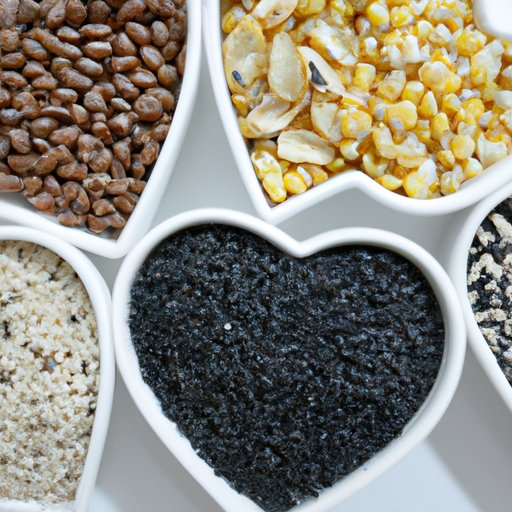Introduction
Whole grains are an important part of a healthy and balanced diet. They are packed with essential vitamins and minerals, protein, fiber, and antioxidants that can help improve overall health and reduce the risk of chronic diseases. In this article, we will explore the many benefits of eating whole grains, how they can benefit your health, and ways to incorporate them into your diet.
How Whole Grains Benefit Your Health
Eating whole grains can provide many health benefits, including improved digestion, lower risk of heart disease, and reduced risk of type 2 diabetes. Let’s take a closer look at some of the nutritional and health benefits of eating whole grains.

Exploring the Nutritional Benefits of Whole Grains
Whole grains are packed with essential vitamins, minerals, protein, and fiber. They also contain antioxidants that can help protect against oxidative stress and damage caused by free radicals. Here’s a closer look at some of the nutrients found in whole grains:
- Vitamins and Minerals: Whole grains are rich in B vitamins, vitamin E, magnesium, selenium, and zinc, which are all important for maintaining good health.
- Protein and Fiber: Whole grains are a great source of both protein and fiber, which can help keep you feeling full longer and promote regular bowel movements.
- Antioxidants: Whole grains contain antioxidants such as phytochemicals and phenolic compounds that can help protect against oxidative stress and damage caused by free radicals.
A Guide to Eating More Whole Grains
When it comes to eating more whole grains, there are several types to choose from, including oats, barley, quinoa, buckwheat, and brown rice. It’s important to note that not all grains are created equal, so be sure to read labels and look for whole grain options. Here are a few ways to add more whole grains to your diet:
- Types of Whole Grains: Look for whole grain breads, pastas, cereals, and other products that are made with 100% whole wheat or other whole grains.
- Add Whole Grains to Meals: Try adding cooked quinoa, millet, or brown rice to soups, salads, and stir-fries for a nutritious boost.
- Snack on Whole Grains: Snack on air-popped popcorn, oatmeal cookies, or whole wheat crackers for a filling snack.

Top Reasons to Eat Whole Grains
Whole grains are incredibly nutritious and can provide many health benefits. Here are some of the top reasons to eat more whole grains:
- Lower Risk of Heart Disease: Eating more whole grains can help lower cholesterol levels and reduce the risk of heart disease.
- Improved Digestion: Whole grains are high in fiber, which can help promote regular bowel movements and improve digestive health.
- Reduced Risk of Type 2 Diabetes: Eating more whole grains can help regulate blood sugar levels and reduce the risk of developing type 2 diabetes.
Understanding the Science Behind Whole Grains
Whole grains are complex carbohydrates that are slowly digested, which helps maintain healthy blood sugar levels. They are also low in fat and high in fiber, making them a great choice for weight loss. Here’s what you need to know about understanding the science behind whole grains:
- How Whole Grains Help Maintain Healthy Blood Sugar Levels: Whole grains are slowly digested, which helps maintain healthy blood sugar levels. This is why they are often recommended for people with diabetes or prediabetes.
- How Whole Grains Help with Weight Loss: Whole grains are low in fat and high in fiber, which can help keep you feeling full longer and aid in weight loss.

What You Need to Know About Whole Grain Foods
When shopping for whole grain foods, it’s important to read labels carefully. Look for products that are labeled “100% whole wheat” or “100% whole grain”. Also, avoid products that have added sugars or refined grains, as these can negate the health benefits of whole grains. Here are a few other tips for choosing whole grain foods:
- Reading Labels: Look for products that are labeled “100% whole wheat” or “100% whole grain”.
- Choosing Whole Grain Foods: Choose products that are made with whole grains, such as whole wheat bread, whole wheat pasta, and brown rice.
Conclusion
Whole grains are an important part of a healthy and balanced diet. They are packed with essential vitamins and minerals, protein, fiber, and antioxidants that can help improve overall health and reduce the risk of chronic diseases. Eating more whole grains can provide many health benefits, such as lower risk of heart disease, improved digestion, and reduced risk of type 2 diabetes. When shopping for whole grain foods, it’s important to read labels carefully and choose products that are made with 100% whole wheat or other whole grains. With these tips, you can easily incorporate more whole grains into your diet and reap the numerous health benefits they offer.
(Note: Is this article not meeting your expectations? Do you have knowledge or insights to share? Unlock new opportunities and expand your reach by joining our authors team. Click Registration to join us and share your expertise with our readers.)
